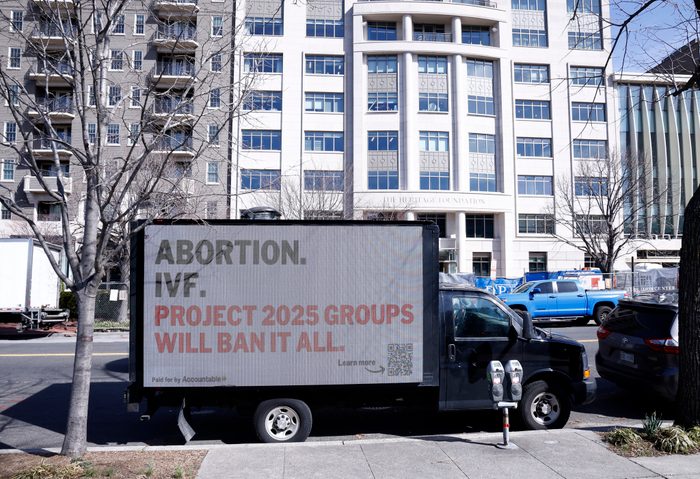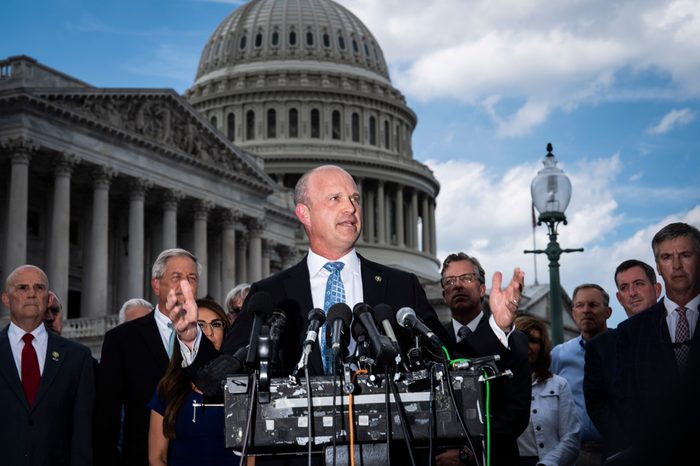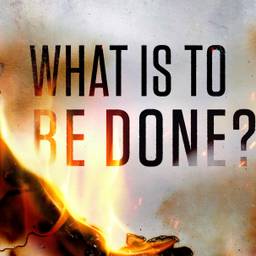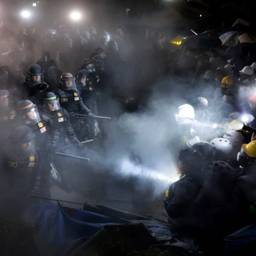Project 2025 Is Dead. Long Live Project 2025.
Trump, Vance and the hateful horizons of “trad futurism.”
Sarah Riccardi-Swartz

On Tuesday afternoon, news broke that Paul Dans, director of the Heritage Foundation’s Project 2025 blueprint for a second Donald Trump presidency, had resigned. For months, politicians and journalists have warned that the initiative — which includes a 900-page policy plan to build a “better country for all Americans” — would amount to radical far-right reordering of the nation.
Recently, the Trump campaign responded to the negative attention by distancing itself from the project — culminating in the campaign’s successful effort to force Dans’s resignation, which created the impression that the project was dead. The Trump campaign quickly released a statement after the news of Dans’s departure, welcoming “reports of Project 2025’s demise” and warning “anyone or any group trying to misrepresent their influence with President Trump and his campaign — it will not end well for you.”
But the record isn’t so easily revised, particularly when the project had participation from numerous Trump advisers and Trump’s own running mate has both praised the ideas from Project 2025 architects as constituting “a genuinely new future for conservatism” and more broadly represents a vital part of the far Right’s future building project.
Trad futurism
When news came several weeks ago that Trump had chosen Ohio Sen. J.D. Vance as his running mate for the 2024 presidential election, my X (formerly Twitter) feed was abuzz with commentary about the selection. Out of the various comments, criticism and praise heaped upon the Hillbilly Elegy author and onetime “Never Trumper” was the assessment of Darrell Scott, pastor of a Cleveland Heights, Ohio, church ministry and one of Trump’s former spiritual advisors.
“JD Vance is not only the pick for today, but also for the future,” Scott proclaimed. “He will be the presumptive nominee for President in 2028, and will keep the MAGA movement going, retaining Trump as an advisor/consigleri [sic]. Rubio, Haley, Burgum, Carson, etc wouldn’t.”
Scott’s emphasis on MAGA’s future vitality caught my eye as a prime example of a phenomenon I call trad futurism, with the Trump campaign’s selection of Vance serving as part of a world-building project aimed at creating a future for the United States that is not founded on the principles of democracy and freedom but rather on identitarian politics and the policing of people and bodies that don’t conform to so-called traditional values.
What is trad futurism? Trad is shorthand for traditionalist/traditionalism. Recently, there has been broad discussion of far-right groups like “trad wives” on TikTok or “rad trad” young Catholics. Trad futurism is part of that conversation, but it’s not just about a return to the simple life or a Latin Mass. Rather it’s a moral project that unites ideologically disparate right-wing groups to craft a world in opposition to secular progressive democracy.
Right-wing writer Rod Dreher’s 2017 book The Benedict Option, which urged Christians to withdraw from a corrupted world into cloistered purist communities of the faithful, is one type of trad future: small and local. But some trad futurist projects are far more expansive, aimed at creating a “moral” future for America, in which laws and social policies reflect the “traditional values” of conservative Christianity. Throughout the United States, various groups of traditionalists are doing their part to build that world.
Christian nationalists position their values as American values. Institutions, including the massive Heritage Foundation and countless other conservative lobbying groups, are courting right-wing leaders and crafting manifestos for their ideal vision of the country’s future.
Religious leaders like the overtly Christian nationalist Idaho pastor Doug Wilson, alt-tech personalities including Gab social media platform founder Andrew Torba and far-right political figures such as white nationalist livestreamer Nicholas Fuentes are all trying to make the future trad. While each has their own vision for what that future looks like, all aim to build a world in which traditional values are the guiding philosophy or rule of law.
Trad futurism is a term I use with Rob Saler, an assistant professor and dean at Christian Theological Seminary in Indiana, to talk about the eventual end product of these far-right world-building plans. Most people are familiar with the concept of world-building from video game design or fantasy writing; think of Tolkien’s Lord of the Rings novels, with their rich depictions of Middle-earth and homey, breakfast-loving hobbits — a fan favorite on the far Right, including Italian Prime Minister Giorgia Meloni and Vance.
In contrast to the fictive Shire and its adventurous Bilbo Baggins, we see world-building as a reactive process that draws together ideology and social design. This happens through enshrining social-moral values into law and embedding religious ideas into governmental structures to build a future that favors those who adhere to or at least accept its boundaries.
This is how trad futurism is built.

Building the future
In the United States, plans are in motion. In March 2024, for example, Idaho House Republicans put forth a resolution to create a traditional family values celebration month. We see states passing restrictive laws on gender-affirming health care and reproductive rights, plus book bans in schools. These laws are not based on human rights but traditional values coming from a far-right reaction to progressive culture.
Perhaps the most important example of trad futurism comes from Project 2025’s model government blueprint, based not on the logics of democratic rule but in specific moralized visions for America’s future.
Project 2025 claims that “Divisive symbols such as the rainbow flag or the Black Lives Matter flag have no place next to the Stars and Stripes at our embassies.” Referencing DEI initiatives, they talk about the “bullying LGBTQ+ agenda.” Biden’s administration is viewed as hostile to “people of faith, especially those with traditional beliefs about marriage, gender, and sexuality.”
At first glance, the document is focused on a future that seems to be about a return to past social values. When we talk about right-wing and far-right groups in the United States, media and research tend to emphasize the language of nostalgia used by these movements as part of their desire to return to some Edenic past or, at the very least, some version of postwar Americana.
But traditionalism is not a project of the past. It is a project of the future; one that draws upon a mix of values that seem nostalgic (particularly in relation to family, gender, sexual, religious and cultural positionings) but are in fact calibrated through moral, messianic and sometimes apocalyptic framings for a traditional future.
What does the Heritage Foundation envision for America’s future? It starts with defense of the family, noting that terms such as “gender equality” or “gender equity” should be omitted from use in government programs. Instead, the authors suggest focusing on the family — strictly defined as heteronormative — since it is “the basic unit of and foundation for a thriving society.” Much in the style of Klan rhetoric from the early 20th century, they position women as the precious commodity of futurecraft, writing that, “Without women, there are no children, and society cannot continue.”
This language of the family — what anthropologist Sophie Bjork James calls “the divine institution” — taps into right-wing fears over the decline of the nuclear (white) family. J.D. Vance’s continuing preoccupation with “cat ladies” and his warnings about American children being replaced by immigrants are part of the larger pronatalist impulse on the far Right.
Children are also used in Project 2025 to advance the Heritage Foundation’s moral vision for their social world. The word “children” appears close to 200 times in the document; many of the entries focus on how children are loved by their biological families, threatened by CDC vaccine mandates and at risk for “confusion over their sex” because of “radical gender ideology” in schools.
Trad world
Interestingly, the ideas found in the Heritage Foundation’s playbook are not dissimilar from those coming from Russian President Vladimir Putin and his religious ally, the Russian Orthodox Church. That’s because trad futurism is already happening in Russia.
Over the last 20 years or so, Putin, along with Patriarch Kirill, the leader of the Russian Orthodox Church, has focused on the project of building Russkiy Mir (the Russian World), an ideology that positions Russia as a religious civilizing force in the world.
Putin uses the idea of traditional values to build the future, arguing that the family, motherhood and children are key to expanding Russian greatness. He has elevated the Orthodox Church to a place of social power and authority and signed laws that declare LGBTQ+ Russians to be extremists. He’s even claimed the invasion of Ukraine was a struggle against the evils of Westernism—a claim reinforced by Kirill’s declaration that gay pride parades were the metaphysical reason Russia invaded Ukraine.
Putin and other far-right traditionalists draw on the work of Julius Evola, a 20th century esoteric philosopher who was further Right than the Italian fascists he critiqued. Evola belonged to a school of thought that focused on the defense of what they cast as primordial, universal truths; racial and sexual purity; and fears over white extinction. Evola’s traditionalist work now inspires the new global far Right in its various expressions.
Traditionalism does not belong to any particular religious denomination or social group; rather, it is way of morally defining who counts. That means it transcends group labels. This is why you can see similar ideological projects happens in two countries that have long been enemies — Russia and the United States.
Ideological terraforming
Traditionalism and trad futurism are a threat to U.S. democracy, for they privilege a moralizing vision for the world over and against the good of the people. We see this expressly in Project 2025.
The manual, which is supported by 100-plus right-wing and far-right groups and institutions, including Moms for Liberty and Hillsdale College, focuses on key anxieties that have troubled the Right since before the culture wars began in earnest in the 1990s: heterosexual marriage, the “white family,” nations, borders. These potent signifiers seem like a nostalgic callback to the 1950s but are in fact a form of trad futurism.
As former Heritage Foundation president Edwin J. Feulner notes in the document, its authors chose to title its conclusion not “Afterword” but “Onward!”

Feulner seems to understand that futurist projects are always about world-building. To build a world — to plan a future — requires ideological terraforming: the process through which a place or society is made more socially, politically or theologically hospitable to those who claim to represent the ruling voice. Constrictive laws, such as those about gender and education, function as social guardrails to keep society on a particular ideological path.
As a terraforming publication aimed at a trad future, Project 2025 provides governmental guardrails to help shape society going forward. Who is left out of this vision for a new U.S. society? LGBTQ+ and BIPOC communities are at most risk. Also in the destructive scope of this document is IDEA (the Individuals with Disabilities Education Act) from 1990 that ensures a free, appropriate public education for all students.
Worried about how “taxpayer dollars” are being used by states, the authors call for micro-savings accounts for parents to utilize at private, even religious, K-12 schools — citing states such as Oklahoma and Florida, in which Christian nationalist schools seem to be models for the future of education. But given that in both Oklahoma and Florida, children with disabilities have been discriminated against in private schools, and private schools are more generally not required to provide support services, this plan would effectively end the idea of a free public education for disabled students, returning to a model that hasn’t existed since the 1970s.
This week’s news about the resignation of Project 2025 director Paul Dans does nothing to lessen the futurist agenda of the Heritage Foundation and its allies. On Tuesday, Heritage Foundation President Kevin Roberts promised that the initiative’s “collective efforts to build a personnel apparatus for policymakers of all levels — federal, state, and local — will continue.” The same day, The New Republic published the foreword that Vance — who has yet to decry Project 2025 — wrote for Roberts’s new book, which advances many of same world-building ideas as Project 2025. In his foreword, Vance calls for “an offensive conservatism, not merely one that tries to prevent the left from doing things we don’t like,” and predicts a coming war in America’s future: “We are now all realizing that it’s time to circle the wagons and load the muskets.”
Even as Trump tries to distance himself from it, an exclusionary future is being built by the Right: one in which disabled, LGBTQ+, BIPOC and politically liberal people simply don’t belong. It’s unclear where a trad futurism project such as Project 2025 might take us as a nation, but if Putin’s Russia is any indicator, we might be looking at state-run media, restricted rights for those who disagree with the government’s vision for society and even jail time for dissidents.
When I reflect on the caustic world-building project of trad futurism — and its goal of enforced conformity to the larger social project of right-wing Christian political domination — I think of Malvina Reynolds’s 1962 song “Little Boxes,” which critiqued the uniformity of California’s whites-only Daly City suburb.
Uniformity is the end goal of trad futurism. It reimagines the past, removed from its historical context, to craft a template for what’s to come.
The antidote to such projects of exclusion is to remember that worlds aren’t built in a day. They take time and planning. This means there are always possibilities for different worlds to emerge instead; worlds built on liberatory visions, which seek not to limit, but expand, who counts in our American future.
Disclosure: The views expressed in this article are held by the author. As a 501(c)(3) nonprofit, In These Times does not support or oppose any candidate for public office.
Sarah Riccardi-Swartz is an assistant professor of religion and anthropology at Northeastern University. She is the author of Between Heaven and Russia: Religious Conversion and Political Apostasy in Appalachia.











